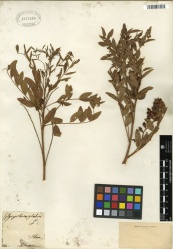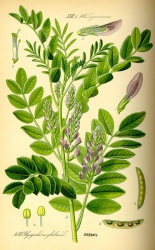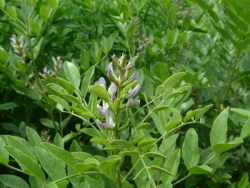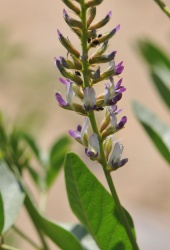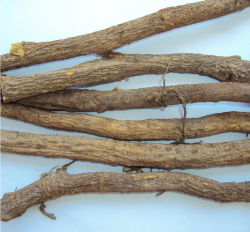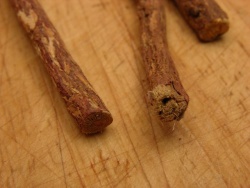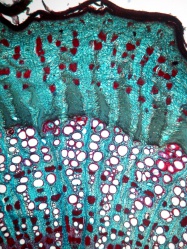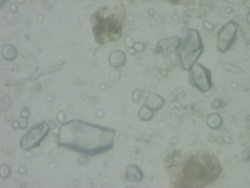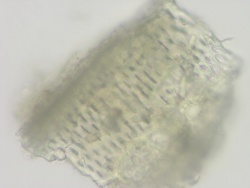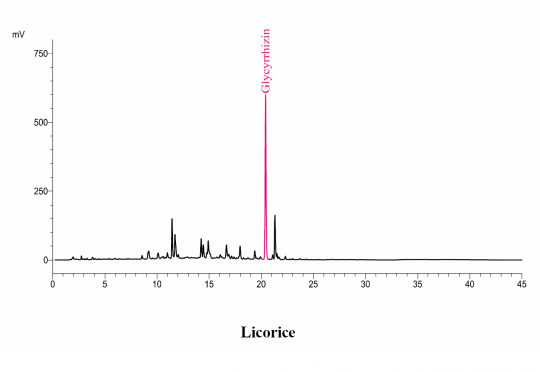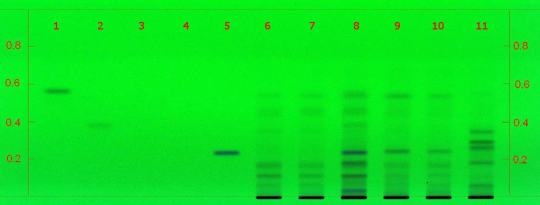Glycyrrhiza glabra (root)
| Line 95: | Line 95: | ||
|caption3=''G. uralensis'' reference standard | |caption3=''G. uralensis'' reference standard | ||
| | | | ||
| − | | description= | + | | description=Sample Preparations: |
| + | Extract 1.0 g of coarsely powdered Glycyrrhiza root in 50 mL of water by boiling for about 5 minutes, and filter. Repeat for 4-5 times or until the extract is colorless. Combine the extracts, concentrate to about 100 mL, and cool to room temperature. Before injection, filter through a membrane filter of 0.45-um or finer pore size, discarding the first 5 mL of the filtrate. | ||
'''Column:''' C18, 25-cm x 4.6 mm, 5-um, XXXXX, XXXXX | '''Column:''' C18, 25-cm x 4.6 mm, 5-um, XXXXX, XXXXX | ||
| Line 109: | Line 110: | ||
'''Injection volume:''' 20 uL | '''Injection volume:''' 20 uL | ||
| − | {| | + | }} |
| + | ===Table=== | ||
| + | {| border=1 | ||
| Time (min) || Solution A (%) || Solution B (%) | | Time (min) || Solution A (%) || Solution B (%) | ||
| + | |- | ||
|0-18 || 95-55 || 5-45 | |0-18 || 95-55 || 5-45 | ||
| + | |- | ||
|18-25 || 55-20 || 45-80 | |18-25 || 55-20 || 45-80 | ||
| + | |- | ||
|25-28 || 20 || 80 | |25-28 || 20 || 80 | ||
| + | |- | ||
|28-35 || 20-55 || 80-45 | |28-35 || 20-55 || 80-45 | ||
| + | |- | ||
|35-40 || 55-95 || 45-5 | |35-40 || 55-95 || 45-5 | ||
| + | |- | ||
|40-45 || 95 || 5 | |40-45 || 95 || 5 | ||
|} | |} | ||
| + | =High Performance Thin Layer Chromatographic Identification= | ||
| + | {{HPTLC | source=AHPA Practical, CAMAG HPTLC | ||
| + | | companyimage=Camag_logo.png | ||
| + | | companyURL=http://www.camag.com/index.php | ||
| + | | mainimage=Camag-blackcohosh-1-d-uv254.png | ||
| + | | caption1=Black cohosh HPTLC ID - Developed, UV 254 nm | ||
| + | | description=Black cohosh (root) (''Actaea racemosa'') | ||
| + | | image2=Camag-blackcohosh-1-d-uv366.png | ||
| + | | caption2=Black cohosh HPTLC ID - Developed, UV 366 nm | ||
| + | | image3=Camag-blackcohosh-1-H2SO4-uv366.png | ||
| + | | caption3=Black cohosh HPTLC ID - Sulfuric acid reagent, UV 366 nm | ||
| + | | image4=Camag-blackcohosh-1-H2SO4-whiteRT.png | ||
| + | | caption4=Black cohosh HPTLC ID Method - Sulfuric acid reagent, white RT | ||
| + | | | ||
| + | | lanes=Lanes, from left to right (Track, Volume, Sample): | ||
| + | |||
| + | | notes= | ||
| + | '''Reference Standard Solution:''' 0.1 mg/mL ammonium glycyrrhizate in ethanol and water (7:3). Or 0.1 mg/mL glycyrrhizic acid in ethanol and water (7:3). | ||
| + | |||
| + | '''Reference Sample Preparations:''' Mix 0.5 g of powdered sample with 10 mL of ethanol and water (7:3, v/v), sonicate for 10 minutes, centrifuge or filter the solution, and use the supernatant / filtrate. | ||
| + | |||
| + | '''Stationary Phase:''' HPTLC, Silica gel 60 F254 | ||
| + | |||
| + | '''Mobile Phase:''' Ethyl acetate, acetic acid, formic acid, water (15:1:1:2) | ||
| + | |||
| + | '''Development:''' Saturate chamber for 20 minutes; developing distance 70 mm from lower edge of the plate; relative humidity 33%, temperature 25°. | ||
| + | |||
| + | '''Derivatization reagent:''' Methanol sulfuric acid reagent- 180 mL of ice-cooled methanol are mixed with 20 mL of sulfuric acid. | ||
| + | |||
| + | '''Detection:''' | ||
| + | a. Examine under UV light at 254 nm | ||
| + | b. Dip (time 0, speed 5) in Derivatization reagent, heat at 100°C for 10 min, leave to cool, and examine under visible light. | ||
| + | |||
| + | '''Procedure:''' | ||
| + | |||
| + | ''Reference Standard Solutions, Stationary Phase, Mobile Phase, Development, Derivatization reagent, and Detection, as described above.'' | ||
| + | |||
| + | '''Test Sample Preparation:''' Prepare test sample as described under Reference Sample Preparations and apply 2 uL. | ||
| + | |||
| + | '''Identification:''' Compare Test Sample Preparation chromatogram with chromatograms of Reference Sample Preparations. The Test Sample Preparation chromatogram is similar to that of the Reference Sample Preparations chromatograms. Additional weak zones may be present. | ||
| + | |||
| + | Under UV light, the Test Sample Preparation chromatogram exhibits a quenching zone in the lower-third section of the chromatogram corresponding to the zone due to ammonium glycyrrhizate in the Reference Standard Solution chromatogram. Above it there are four quenching zones corresponding to those marked with red arrows in the Reference Sample Preparations chromatograms. | ||
| + | |||
| + | After derivatization and under visible light, the Test Sample Preparation chromatogram exhibits a brown zone in the lower-third section of the chromatogram corresponding to the zone due to ammonium glycyrrhizate in the Reference Standard Solution chromatogram. Above it there are four yellow zones corresponding to those marked with black arrows in the Reference Sample Preparations chromatograms. | ||
| + | |||
| + | ''Note: Images presented in this entry are examples and are not intended to be used as a bases for setting specifications for quality control purposes.'' | ||
| + | | }} | ||
| − | |||
| − | |||
=Supplementary Information= | =Supplementary Information= | ||
Revision as of 15:57, 28 February 2014
Contents |
Nomenclature
Botanical Voucher Specimen
|
|
Organoleptic Characteristics
|
Macroscopic Characteristics
|
Microscopic Characteristics
|
High Performance Liquid Chromatographic Identification
Sample Preparations: Extract 1.0 g of coarsely powdered Glycyrrhiza root in 50 mL of water by boiling for about 5 minutes, and filter. Repeat for 4-5 times or until the extract is colorless. Combine the extracts, concentrate to about 100 mL, and cool to room temperature. Before injection, filter through a membrane filter of 0.45-um or finer pore size, discarding the first 5 mL of the filtrate.
Column: C18, 25-cm x 4.6 mm, 5-um, XXXXX, XXXXX
Mobile Phase: 0.14 g of anhydrous potassium dihydrogen phosphate in 900 mL of water, add 0.5 mL phosphoric acid, mix, complete to volume with water, and mix (Solution A); and acetonitrile (Solution B)
Elution: gradient program, see Table below
Flow rate: 1.5 mL/min
Detection: UV, 254 nm
Injection volume: 20 uL
Source: Natural Remedies Pvt Ltd [14]
Table
| Time (min) | Solution A (%) | Solution B (%) |
| 0-18 | 95-55 | 5-45 |
| 18-25 | 55-20 | 45-80 |
| 25-28 | 20 | 80 |
| 28-35 | 20-55 | 80-45 |
| 35-40 | 55-95 | 45-5 |
| 40-45 | 95 | 5 |
High Performance Thin Layer Chromatographic Identification
|
Black cohosh (root) (Actaea racemosa) Lane Assignments Lanes, from left to right (Track, Volume, Sample): Other Notes Reference Standard Solution: 0.1 mg/mL ammonium glycyrrhizate in ethanol and water (7:3). Or 0.1 mg/mL glycyrrhizic acid in ethanol and water (7:3). Reference Sample Preparations: Mix 0.5 g of powdered sample with 10 mL of ethanol and water (7:3, v/v), sonicate for 10 minutes, centrifuge or filter the solution, and use the supernatant / filtrate. Stationary Phase: HPTLC, Silica gel 60 F254 Mobile Phase: Ethyl acetate, acetic acid, formic acid, water (15:1:1:2) Development: Saturate chamber for 20 minutes; developing distance 70 mm from lower edge of the plate; relative humidity 33%, temperature 25°. Derivatization reagent: Methanol sulfuric acid reagent- 180 mL of ice-cooled methanol are mixed with 20 mL of sulfuric acid. Detection: a. Examine under UV light at 254 nm b. Dip (time 0, speed 5) in Derivatization reagent, heat at 100°C for 10 min, leave to cool, and examine under visible light. Procedure: Reference Standard Solutions, Stationary Phase, Mobile Phase, Development, Derivatization reagent, and Detection, as described above. Test Sample Preparation: Prepare test sample as described under Reference Sample Preparations and apply 2 uL. Identification: Compare Test Sample Preparation chromatogram with chromatograms of Reference Sample Preparations. The Test Sample Preparation chromatogram is similar to that of the Reference Sample Preparations chromatograms. Additional weak zones may be present. Under UV light, the Test Sample Preparation chromatogram exhibits a quenching zone in the lower-third section of the chromatogram corresponding to the zone due to ammonium glycyrrhizate in the Reference Standard Solution chromatogram. Above it there are four quenching zones corresponding to those marked with red arrows in the Reference Sample Preparations chromatograms. After derivatization and under visible light, the Test Sample Preparation chromatogram exhibits a brown zone in the lower-third section of the chromatogram corresponding to the zone due to ammonium glycyrrhizate in the Reference Standard Solution chromatogram. Above it there are four yellow zones corresponding to those marked with black arrows in the Reference Sample Preparations chromatograms. Note: Images presented in this entry are examples and are not intended to be used as a bases for setting specifications for quality control purposes. Source: AHPA Practical, CAMAG HPTLC [15] |
Supplementary Information
Sources
- ↑ Tropicos.org. Missouri Botanical Garden. 27 Feb 2014 <http://www.tropicos.org/Image/100253567>
- ↑ Natural Remedies Pvt Ltd http://www.naturalremedy.com/
- ↑ American Herbal Products Association. March 2013. Organoleptic Analysis of Herbal Ingredients. AHPA: Silver Spring, MD http://www.ahpa.org/
- ↑ Natural Remedies Pvt Ltd http://www.naturalremedy.com/
- ↑ Flora von Deutschland, Österreich und der Schweiz- Otto Wilhelm Thomé (1885)
- ↑ Encyclopedia of Life http://eol.org/data_objects/2447928
- ↑ Encyclopedia of Life http://eol.org/data_objects/24932881
- ↑ Natural Remedies Pvt Ltd http://www.naturalremedy.com/
- ↑ Encyclopedia of Life http://eol.org/data_objects/19163752
- ↑ Natural Remedies Pvt Ltd http://www.naturalremedy.com/
- ↑ Natural Remedies Pvt Ltd http://www.naturalremedy.com/
- ↑ Natural Remedies Pvt Ltd http://www.naturalremedy.com/
- ↑ Natural Remedies Pvt Ltd http://www.naturalremedy.com/
- ↑ Natural Remedies Pvt Ltd http://www.naturalremedy.com/
- ↑ AHPA Practical, CAMAG HPTLC http://www.camag.com/index.php
